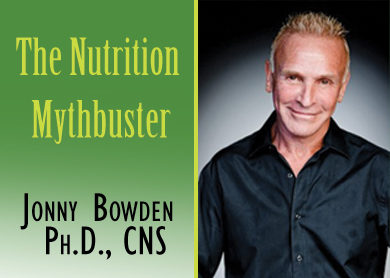If you’ve ever slapped your palm to your forehead and rolled your eyes at the way the media reports nutrition information, well, have I got a teaching moment for you!
All you’ve got to do is watch the headlines on e-cigarettes.
Now, let’s be clear. I’m no fan of e-cigarettes. I’m pretty sure that as more research comes out, we’re going to find all kinds of reasons why inhaling dumb, colored, flavored chemicals in a cloud of hot vapor is probably not a good idea.
That said, the media reporting on this subject has been both hysterical and irresponsible.
So here’s the deal.
Research recently came out in the New England Journal of Medicine that seemed to indicate that e-cigarettes could produce high levels of formaldehyde, which we know, is a poison. The media went to town! Here are a couple of the headlines: “High Levels of Formaldehyde Hidden in E-cigarettes,” “E-cigarettes Not Safer than Ordinary Cigarettes,” and from CBS News, “E-cigarette vapor has cancer-causing chemical.”
If these headlines remind you of the rash of “omega-3’s cause prostate cancer” headlines last year, well, they should. Both sets of headlines were completely inaccurate and wonderful examples of how bad a job the media does on reporting research.
All this negative publicity made a lot of people who were thinking about quitting cigarettes have second thoughts. “What the heck!”, they probably said to themselves. “If these e-cigarettes are just as bad, if not worse, than regular cigarettes, why bother quitting? I might as well stick with my Marlboros.”
So was that research accurately reported? Let’s go to the videotape.
The study focused on a premium vaporizer that heats flavored liquid containing nicotine to turn it into a vapor, which the user then inhales. Almost all of these devices let you run them at either low or high voltage. The researchers ran the device at both temperatures; at the low temperature they detected exactly zero formaldehyde, at the high temperature they did in fact detect some formaldehyde.
But here's the thing. No normal person would ever run these things at high voltage, because when you vaporize at high voltage it causes an absolutely disgusting taste and you can’t inhale it!
There have been human studies of vaping that found that once you’re above a certain temperature—which by the way was even lower than the high temperature that the researchers used in the study—nobody could even inhale, the taste was so unbearable!
So what you have here is the media reporting on a theoretical possibility that would never have happened in real life. It would be like testing the results of eating a food that had been seasoned with arsenic and then reporting that the food was unhealthy.
I see this with vitamin studies all the time. They test the wrong form, the wrong dose and the wrong length of time, and the media runs with a headline that has just about nothing to do with what the research actually said.
When The New York Times asked one of the authors of the e-cig study, David Peyton, about the media coverage, he replied, “What the media is reporting has nothing to do with our study. It is exceedingly frustrating to me that we are being associated with saying that e-cigarettes are more dangerous than cigarettes when, in fact, that is not in evidence.”
The Times even told Peyton about a tweet that the New England Journal of Medicine had put out, which said that the authors of the study projected a higher cancer risk with e-cigarettes than with regular cigarettes. Peyton looked crestfallen and said, “I regret that. That is not my opinion.”
By the way—if you’re wondering why this matters, here’s the answer.
E-cigarettes suck, but they suck waaaay less than real cigarettes. And the fact that there are some dangers with them shouldn’t obscure the fact that moving from Camels to e-cigs is a huge step upward, a fact that’s getting completely lost here, thanks to the mainstream media’s utter inability to do nuance.
In general, the media does a poor job of reporting research, whether it's on heart disease, cholesterol, diet or nutritional supplements. That's because research is almost always more complicated than what can fit into a sound bite. To say that e-cigarettes run on two different voltages—one that e-smokers actually use, and one that no e-smoker would ever use—and that the one that nobody uses produces formaldehyde doesn’t make for an exciting or sexy story.
But to say e-cigarettes cause cancer, well, that's a headline people will read!
It just happens not to be true.
Take what you read in the media about health research with a grain of salt. Read commentaries; go to the blogs of the people you trust, and dig a little deeper.
You'll almost always find that the headline—especially when the story is about health, nutrition, or supplements—is a poor representation of what actually happened in the research. WF
 Jonny Bowden, “the Nutrition Myth Buster”™ is a board-certified nutritionist and the best-selling author of The Great Cholesterol Myth and 13 other books. Visit him at www.jonnybowden.com.
Jonny Bowden, “the Nutrition Myth Buster”™ is a board-certified nutritionist and the best-selling author of The Great Cholesterol Myth and 13 other books. Visit him at www.jonnybowden.com.
Posted on WholeFoods Magazine Online, 6/11/15
NOTE: The statements presented in this column should not be considered medical advice or a way to diagnose or treat any disease or illness. Dietary supplements do not treat, cure or prevent any disease. Always seek the advice of a medical professional before altering your daily dietary regimen. The opinions presented here are those of the writer. WholeFoods Magazine does not endorse any specific company, brand or product.
Posted 7/14/2015










